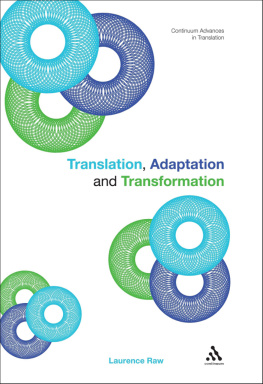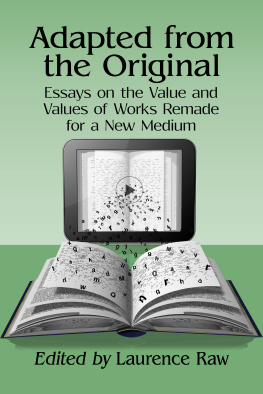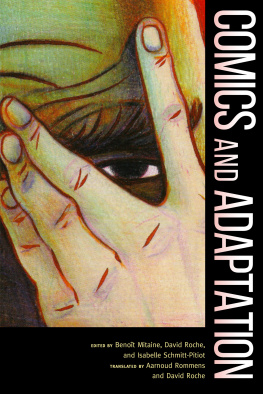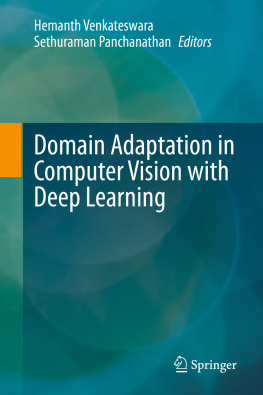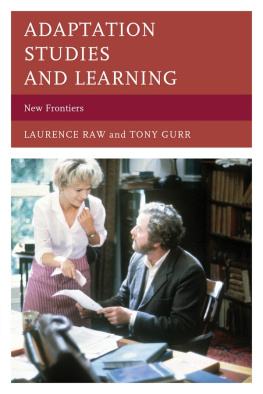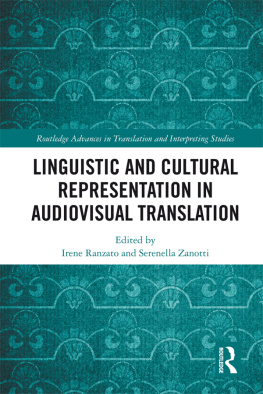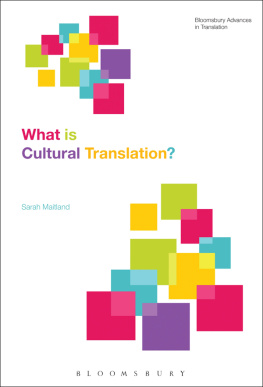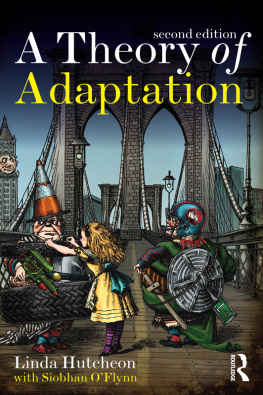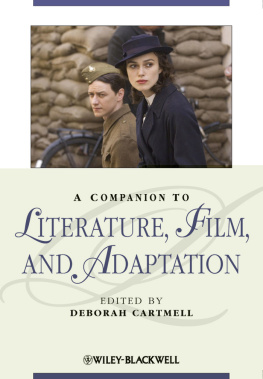Continuum Advances in Translation
Series Editor:
Jeremy Munday, Centre for Translation Studies, University of Leeds
Published in association with the International Association for Translation and Intercultural Studies (IATIS), Continuum Studies in Translation aims to present a series of books focused around central issues in translation and interpreting. Using case studies drawn from a wide range of different countries and languages, each book presents a comprehensive examination of current areas of research within translation studies written by academics at the forefront of the field. The thought-provoking books in this series are aimed at advanced students and researchers of translation studies.
Cognitive Explorations of Translation: Eyes, Keys, Taps
Edited by Sharon OBrien
Media Translation
Edited by Judith Inggs and Libby Meintjes
Translation as Intervention
Edited by Jeremy Munday
Translation Studies in Africa: Central Issues in Interpreting and Literary and Translation: Theory and Practice in Dialogue
Edited by Rebecca Hyde Parker, Karla L. Guadarrama Garca, and Antoinette Fawcett
Translator and Interpreter Training: Issues, Methods, and Debates
Edited by John Kearns

Bloomsbury T&T Clark
An imprint of Bloomsbury Publishing Plc
Imprint previously known as T&T Clark
50 Bedford Square | 1385 Broadway |
London | New York |
WC1B 3DP | NY 10018 |
UK | USA |
www.bloomsbury.com
BLOOMSBURY, T&T CLARK and the Diana logo are trademarks of Bloomsbury publishing Plc
First published 2012 by Continuum International Publishing Group
Copyright Laurence Raw and Contributors 2012
Ian Bradley has asserted his right under the Copyright, Designs and Patents Act, 1988, to be identified as Author of this work.
All rights reserved.
No part of this publication may be reproduced or transmitted in any form or by any means, electronic or mechanical, including photocopying, recording, or any information storage or retrieval system, without prior permission in writing from the publishers.
No responsibility for loss caused to any individual or organization acting on or refraining form action as a result of the material in this publication can be accepted by Bloomsbury or the author.
Library of Congress Cataloguing-in-Publication Data
Translation, adaptation and transformation / edited by Laurence Raw.
p. cm. (Continuum advances in translation studies)
Includes bibliographical references and index.
ISBN 978-1-4411-0856-2 (hardcover) ISBN 978-1-4411-4348-8 (ebook (pdf)) - ISBN 978-1-4411-5784-3 (ebook (epub)) 1. Translating and interpretingStudy and teaching. I. Raw, Laurence.
P306.5.T728 2011
418.02--dc23
ISBN: HB: 978-1-4411-0856-2
PB: 978-1-4725-3129-2
ePDF: 978-1-4411-4348-8
ePub: 978-1-4411-5784-3
Typeset by Newgen Imaging Systems Pvt Ltd, Chennai, India
Contents
The aim of this new series is to provide an outlet for advanced research in the broad interdisciplinary field of translation studies. Consisting of monographs and edited themed collections of the latest work, it should be of particular interest to academics and postgraduate students researching in translation studies and related fields, and also to advanced students studying translation and interpreting modules.
Translation studies has enjoyed huge international growth over recent decades in tandem with the expansion in both the practice of translation globally and in related academic programs. The understanding of the concept of translation itself has broadened to include not only interlingual but also various forms of intralingual translation. Specialized branches or sub-disciplines have developed for the study of interpreting, audiovisual translation, and sign language, among others. Translation studies has also come to embrace a wide range of types of intercultural encounter and transfer, interfacing with disciplines as varied as applied linguistics, comparative literature, computational linguistics, creative writing, cultural studies, gender studies, philosophy, postcolonial studies, sociology, and so on. Each provides a different and valid perspective on translation, and each has its place in this series.
This is an exciting time for translation studies, and the new Continuum Advances in Translation Studies series promises to be an important new plank in the development of the discipline. As General Editor, I look forward to overseeing the publication of important new work that will provide insights into all aspects of the field.
Jeremy Munday
General Editor
University of Leeds, UK
Piotr Kuhiwczak
The terms adaptation and translation have many contextual meanings. In a cultural and literary context, adaptation signals the change of medium through which meaning is communicated. In a wider social context the term acquires even more meanings and generates a wider range of associations. To be able to adapt means to be able to survive or navigate in uncharted territory without losing an intrinsic sense of identity. Walter Benjamins essay The Task of the Translator sees translation as a strategy that allows texts to survive and adapt to a new cultural milieu. Paradoxically, the essay (which was written in 1923) has survived because of its multiple translations and disagreements among scholars about the possible interpretations of what Benjamin intended to communicate. So the history of the essays reception serves as the best illustration for Benjamins thesis about the adaptive power of translation.
Interest in The Task of the Translator was not the case of an accidental revival of a forgotten intellectual work. The essay was rediscovered at a particular historical juncture when translation began to be viewed as something more than simple decoding and recoding of printed text. It would be pointless to argue what came first the rediscovery of Benjamins essay or the rise of interest in translation as a cultural phenomenon. Lets agree that the two discoveries were interconnected and took place sometime in the late 1970s and the early 1980s. In countries with a long history of multilingual communication, translation was viewed as a significant cultural and social phenomenon, but in the English-speaking countries this was not the case. It was a combination of genius, clever planning and pure coincidence that in the early 1980s Warwick University established a research centre devoted to what is commonly called now translation studies. At that time the term was completely new, and many viewed it if not with hostility, then at least with considerable suspicion. The uniqueness of the centre rested in its interdisciplinary nature because it attracted scholars from related but distinct disciplines. They put aside many differences in the name of intellectual curiosity and set out to adapt to what this unusual combination of subjects could produce. The cocktail of subjects included comparative literature, cultural studies, applied linguistics, history, media studies, literary theory and postcolonial studies and at some point politics and sociology. Despite a good dose of scepticism surrounding the centre, the experiment survived and expanded. Publications began to proliferate, conferences were attended by scholars from all corners of the world and postgraduate students were willing to spend several years at Warwick to be supervised by staff at what was then known as the Centre for Translation and Comparative Cultural Studies (CTCCS).

